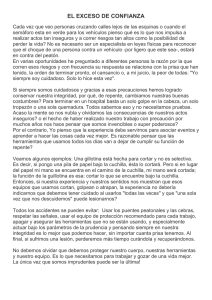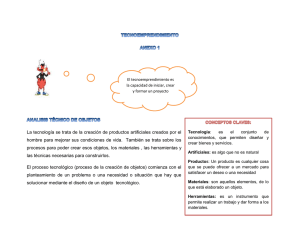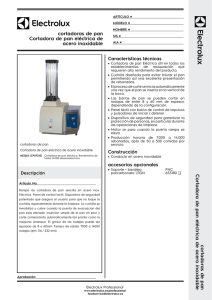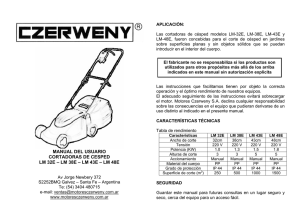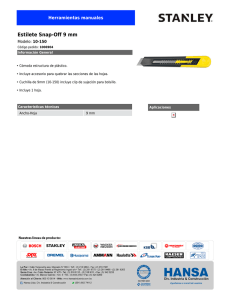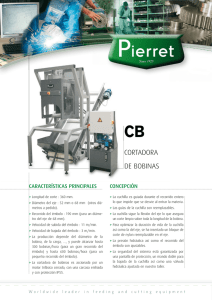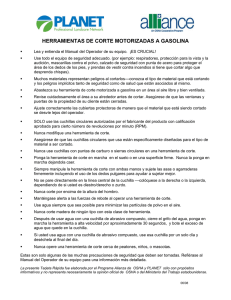3000N-4000N Globe CleanSanitizeInspect_Slicer Wall
Anuncio
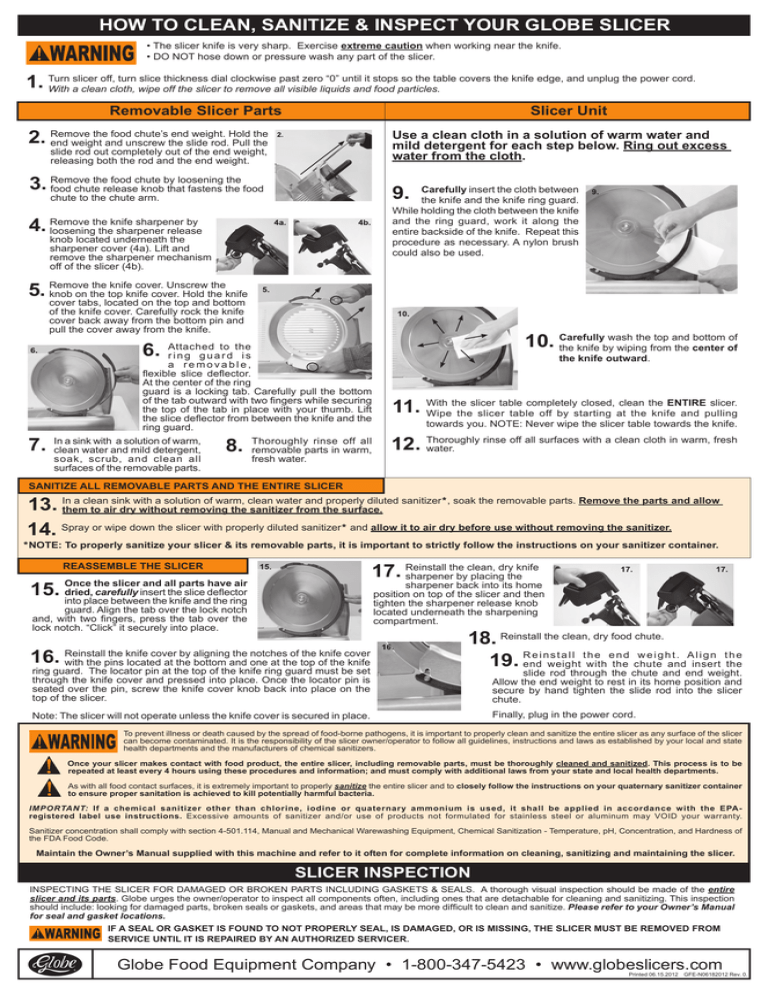
HOW TO CLEAN, SANITIZE & INSPECT YOUR GLOBE SLICER • The slicer knife is very sharp. Exercise extreme caution when working near the knife. • DO NOT hose down or pressure wash any part of the slicer. slicer off, turn slice thickness dial clockwise past zero “0” until it stops so the table covers the knife edge, and unplug the power cord. 1. Turn With a clean cloth, wipe off the slicer to remove all visible liquids and food particles. Removable Slicer Parts Slicer Unit the food chute’s end weight. Hold the 2. Remove end weight and unscrew the slide rod. Pull the Use a clean cloth in a solution of warm water and mild detergent for each step below. Ring out excess water from the cloth. slide rod out completely out of the end weight, releasing both the rod and the end weight. the food chute by loosening the 3. Remove food chute release knob that fastens the food 9. Carefully insert the cloth between the knife and the knife ring guard. While holding the cloth between the knife and the ring guard, work it along the entire backside of the knife. Repeat this procedure as necessary. A nylon brush could also be used. chute to the chute arm. the knife sharpener by 4. Remove loosening the sharpener release knob located underneath the sharpener cover (4a). Lift and remove the sharpener mechanism off of the slicer (4b). the knife cover. Unscrew the 5. Remove knob on the top knife cover. Hold the knife cover tabs, located on the top and bottom of the knife cover. Carefully rock the knife cover back away from the bottom pin and pull the cover away from the knife. wash the top and bottom of 10. Carefully the knife by wiping from the center of 6. 7. Attached to the ring guard is a removable, flexible slice deflector. At the center of the ring guard is a locking tab. Carefully pull the bottom of the tab outward with two fingers while securing the top of the tab in place with your thumb. Lift the slice deflector from between the knife and the ring guard. In a sink with a solution of warm, clean water and mild detergent, soak, scrub, and clean all surfaces of the removable parts. 8. Thoroughly rinse off all removable parts in warm, fresh water. the knife outward. the slicer table completely closed, clean the ENTIRE slicer. 11. With Wipe the slicer table off by starting at the knife and pulling towards you. NOTE: Never wipe the slicer table towards the knife. rinse off all surfaces with a clean cloth in warm, fresh 12. Thoroughly water. SANITIZE ALL REMOVABLE PARTS AND THE ENTIRE SLICER a clean sink with a solution of warm, clean water and properly diluted sanitizer*, soak the removable parts. Remove the parts and allow 13. Inthem to air dry without removing the sanitizer from the surface. 14. Spray or wipe down the slicer with properly diluted sanitizer* and allow it to air dry before use without removing the sanitizer. *NOTE: To properly sanitize your slicer & its removable parts, it is important to strictly follow the instructions on your sanitizer container. the clean, dry knife 17. Reinstall sharpener by placing the REASSEMBLE THE SLICER carefully insert the slice deflector 15. dried, into place between the knife and the ring Once the slicer and all parts have air sharpener back into its home position on top of the slicer and then tighten the sharpener release knob located underneath the sharpening compartment. guard. Align the tab over the lock notch and, with two fingers, press the tab over the lock notch. “Click” it securely into place. the knife cover by aligning the notches of the knife cover 16. Reinstall with the pins located at the bottom and one at the top of the knife ring guard. The locator pin at the top of the knife ring guard must be set through the knife cover and pressed into place. Once the locator pin is seated over the pin, screw the knife cover knob back into place on the top of the slicer. 18. Reinstall the clean, dry food chute. stall the end weight. Align the 19. Rende i nweight with the chute and insert the Note: The slicer will not operate unless the knife cover is secured in place. slide rod through the chute and end weight. Allow the end weight to rest in its home position and secure by hand tighten the slide rod into the slicer chute. Finally, plug in the power cord. To prevent illness or death caused by the spread of food-borne pathogens, it is important to properly clean and sanitize the entire slicer as any surface of the slicer can become contaminated. It is the responsibility of the slicer owner/operator to follow all guidelines, instructions and laws as established by your local and state health departments and the manufacturers of chemical sanitizers. Once your slicer makes contact with food product, the entire slicer, including removable parts, must be thoroughly cleaned and sanitized. This process is to be repeated at least every 4 hours using these procedures and information; and must comply with additional laws from your state and local health departments. As with all food contact surfaces, it is extremely important to properly sanitize the entire slicer and to closely follow the instructions on your quaternary sanitizer container to ensure proper sanitation is achieved to kill potentially harmful bacteria. IMPORTANT: If a chemical sanitizer other than chlorine, iodine or quaternary ammonium is used, it shall be applied in accordance with the EPAregistered label use instructions. Excessive amounts of sanitizer and/or use of products not formulated for stainless steel or aluminum may VOID your warranty. Sanitizer concentration shall comply with section 4-501.114, Manual and Mechanical Warewashing Equipment, Chemical Sanitization - Temperature, pH, Concentration, and Hardness of the FDA Food Code. Maintain the Owner’s Manual supplied with this machine and refer to it often for complete information on cleaning, sanitizing and maintaining the slicer. SLICER INSPECTION INSPECTING THE SLICER FOR DAMAGED OR BROKEN PARTS INCLUDING GASKETS & SEALS. A thorough visual inspection should be made of the entire slicer and its parts. Globe urges the owner/operator to inspect all components often, including ones that are detachable for cleaning and sanitizing. This inspection should include: looking for damaged parts, broken seals or gaskets, and areas that may be more difficult to clean and sanitize. Please refer to your Owner’s Manual for seal and gasket locations. IF A SEAL OR GASKET IS FOUND TO NOT PROPERLY SEAL, IS DAMAGED, OR IS MISSING, THE SLICER MUST BE REMOVED FROM SERVICE UNTIL IT IS REPAIRED BY AN AUTHORIZED SERVICER. Globe Food Equipment Company • 1-800-347-5423 • www.globeslicers.com Printed 06.15.2012 GFE-N06182012 Rev. 0. CÓMO LIMPIAR, DESINFECTAR E INSPECCIONAR SU CORTADORA GASTRONÓMICA GLOBE • La cuchilla de la cortadora es muy filosa. Tenga mucho cuidado al trabajar cerca de la cuchilla. • NO lave ninguna parte de la cortadora con manguera ni con agua a presión. la cortadora, gire el dial de espesor de lonja completamente hacia la derecha, pasando el cero “0”, hasta que se detenga, para que se 1. Apague cubra el borde de la cuchilla y desenchufe el cable de alimentación. Use un paño limpio para limpiar la cortadora y quitar todas las partículas de alimentos y líquidos visibles. Partes desmontables de la cortadora Unidad de la cortadora el contrapeso del carro deslizante de 2. Quite alimentos. Sujete el contrapeso y desenrosque la Use un paño limpio en una solución de agua tibia con un detergente suave para cada uno de los pasos que se mencionan a continuación. Escurra el exceso de agua del paño. barra de mando deslizante. Tire la barra de mando deslizante para quitarla del pivote de contrapeso, liberando así la barra de mando y el contrapeso. el carro deslizante de alimentos aflojando la 3. Quite perilla de desenganche del carro deslizante que lo 9. Con cuidado, coloque el paño entre la cuchilla y el anillo protector de la cuchilla. Mientras sujeta el paño entre la cuchilla y el anillo protector, limpie a lo largo de toda la parte posterior de la cuchilla. Repita este procedimiento según sea necesario. También es posible usar un cepillo de nailon. sujeta al brazo del carro. la perilla de desenganche 4. afldelojando afilador ubicada en la parte Quite el afilador de la cuchilla inferior de la cubierta del afilador (4a). Levante y quite el mecanismo afilador de la cortadora (4b). la cubierta de la cuchilla. Desenrosque 5. Quite la perilla en la parte superior de la cubierta de la cuchilla. Sujete la cubierta de la cuchilla por las lengüetas, ubicadas en la parte superior e inferior de la cubierta de la cuchilla. Con cuidado, retire la cubierta de la cuchilla del pasador de la parte inferior y quite la cubierta de la cuchilla. Junto al anillo p r o t e c t o r , encontrará un deflector de lonchas, flexible y desmontable. En el centro del anillo protector encontrará una lengüeta de bloqueo. Con cuidado, tire la parte inferior de la lengüeta hacia afuera con dos dedos mientras fija la parte superior de la lengüeta en su lugar con el pulgar. Levante el deflector de lonchas entre la cuchilla y el anillo protector. Deje en remojo, friegue y limpie Enjuague profundamente todas las superficies de las partes todas las partes desmontables en un fregadero desmontables con agua usando una solución de agua limpia potable y tibia. y tibia con un detergente suave. cuidado, lave la parte superior 10. eConinferior de la cuchilla con un paño desde el centro de la cuchilla hacia afuera. 6. 7. 8. el protector de cuchilla de la cortadora completamente cerrado, 11. Con limpie TODA la cortadora. Limpie con un paño el protector de la cortadora comenzando por la cuchilla en dirección hacia usted. NOTA: Nunca limpie el protector de la cortadora hacia la cuchilla. profundamente todas las superficies con un paño y agua 12. Enjuague potable y tibia. DESINFECTE TODAS LAS PARTES DESMONTABLES Y TODA LA CORTADORA en remojo las partes desmontables en una solución de agua limpia y tibia con desinfectante* correctamente diluido en un fregadero limpio. Quite las 13. Deje partes para que se sequen al aire sin quitar el desinfectante. Aplique con un pulverizador o con un paño desinfectante* correctamente diluido en la cortadora y deje que se seque al aire antes de su uso sin quitar el 14. desinfectante. *NOTA: Para desinfectar correctamente su cortadora y sus partes desmontables, es importante que siga estrictamente las instrucciones del envase del desinfectante. a instalar el afilador de la 17. Vuelva cuchilla limpio y seco colocando VUELVA A ARMAR LA CORTADORA se hayan secado, con cuidado, 15. partes coloque el deflector de lonchas en su lugar Una vez que la cortadora y todas sus entre la cuchilla y el anillo protector. Alinee la lengüeta con la muesca de bloqueo y, con dos dedos, presione la lengüeta sobre la muesca de bloqueo. Cuando haga “clic” estará bien sujeta en forma segura en su lugar. a instalar la cubierta de la cuchilla alineando las muescas de la 16. Vuelva cubierta de la cuchilla con los pasadores ubicados en la parte inferior y uno en la parte superior del anillo protector de la cuchilla. El pasador localizador ubicado en la parte superior del anillo protector de la cuchilla debe fijarse a través de la cubierta de la cuchilla y presionarse hasta que quede en su lugar. Una vez que el pasador localizador se encuentre fijo sobre el pasador, enrosque la perilla de la cubierta de la cuchilla nuevamente en su lugar, sobre la parte superior de la cortadora. Nota: La cortadora no funcionará hasta que la cubierta de la cuchilla esté colocada en forma segura en su lugar. el afilador nuevamente en su posición inicial sobre la parte superior de la cortadora y luego ajuste la perilla de desenganche del afilador ubicada en la parte inferior del compartimento del afilador. Vuelva a instalar el carro deslizante de alimentos limpio y seco. 18. a instalar el contrapeso. Alinee el contrapeso con el carro deslizante e inserte la barra de mando 19. Vuelva deslizante a través del punto de pivote del contrapeso y el carro. Permita que el contrapeso apoyado en la posición bloqueada y enrosque hasta sujetar firmemente la barra de mando deslizante en el carro deslizante de la cortadora. Finalmente, enchufe el cable de alimentación. Para evitar enfermedades o la muerte provocada por la propagación de patógenos transmitidos por alimentos, es importante limpiar y desinfectar correctamente la toda la cortadora ya que cualquier superficie de la cortadora puede contaminarse. Es responsabilidad del propietario/operario de la cortadora seguir todas las pautas, instrucciones y leyes que establecen los departamentos sanitarios locales y estatales y los fabricantes de desinfectantes químicos. Una vez que la cortadora entre en contacto con el producto alimenticio, toda la cortadora, incluidas las partes desmontables, deben estar profundamente limpias y desinfectadas. Este proceso se debe repetir como mínimo cada 4 horas usando estos procedimientos y esta información; y se debe cumplir con cualquier otra ley adicional de los departamentos sanitarios locales y estatales. Al igual que con todas las superficies de contacto con alimentos, es sumamente importante desinfectar toda la cortadora y seguir detenidamente las instrucciones que figuran en el envase de su desinfectante cuaternario para asegurar las condiciones de salubridad adecuadas para eliminar las bacterias potencialmente perjudiciales. IMPORTANTE: Si se usa un desinfectante químico que no sea cloro, yodo o amonio cuaternario, se debe aplicar según las instrucciones de uso de las etiquetas registradas por parte de la Agencia de Protección Ambiental (EPA, por sus siglas en inglés). Las cantidades excesivas de desinfectante o el uso de productos que no han sido formulados para el acero inoxidable o el aluminio pueden ANULAR su garantía. La concentración de desinfectante debe cumplir con la sección 4-501.114, del Equipo Manual y Mecánico para Lavado de Equipo y Utensilios, desinfección química: temperatura, pH, concentración y dureza del Código Alimentario de la Administración de Medicamentos y Alimentos (FDA, por sus siglas en inglés). Conserve el Manual del propietario proporcionado con esta máquina y consúltelo a menudo para obtener información completa sobre la limpieza, la desinfección y el mantenimiento de la cortadora. SLICER INSPECTION INSPECCIONAR LA CORTADORA PARA DETECTAR PARTES DAÑADAS O AVERIADAS, INCLUYENDO LAS JUNTAS Y LOS CIERRES. Se debe realizar una inspección visual minuciosa de la toda la cortadora y sus partes. Globe le recomienda encarecidamente al propietario/operario inspeccionar a menudo todos los componentes, incluidos los que son desmontables para su limpieza y desinfección. Esta inspección debe incluir lo siguiente: búsqueda de partes dañadas, juntas o cierres averiados y áreas que pueden resultar más difíciles de limpiar y desinfectar. Consulte el manual del propietario para conocer la ubicación de las juntas y los cierres. EN CASO DE ENCONTRAR UNA JUNTA O UN CIERRE QUE NO ESTÉ CORRECTAMENTE SELLADO, QUE ESTÉ DAÑADO O QUE FALTE, LA CORTADORA DEBERÁ ESTABLECERSE COMO FUERA DE SERVICIO HASTA QUE SEA REPARADA POR UN PROVEEDOR DE SERVICIOS AUTORIZADO. Globe Food Equipment Company • 1-800-347-5423 • www.globeslicers.com Printed 06.15.2013 GFE-N06132013 Rev. 0.
